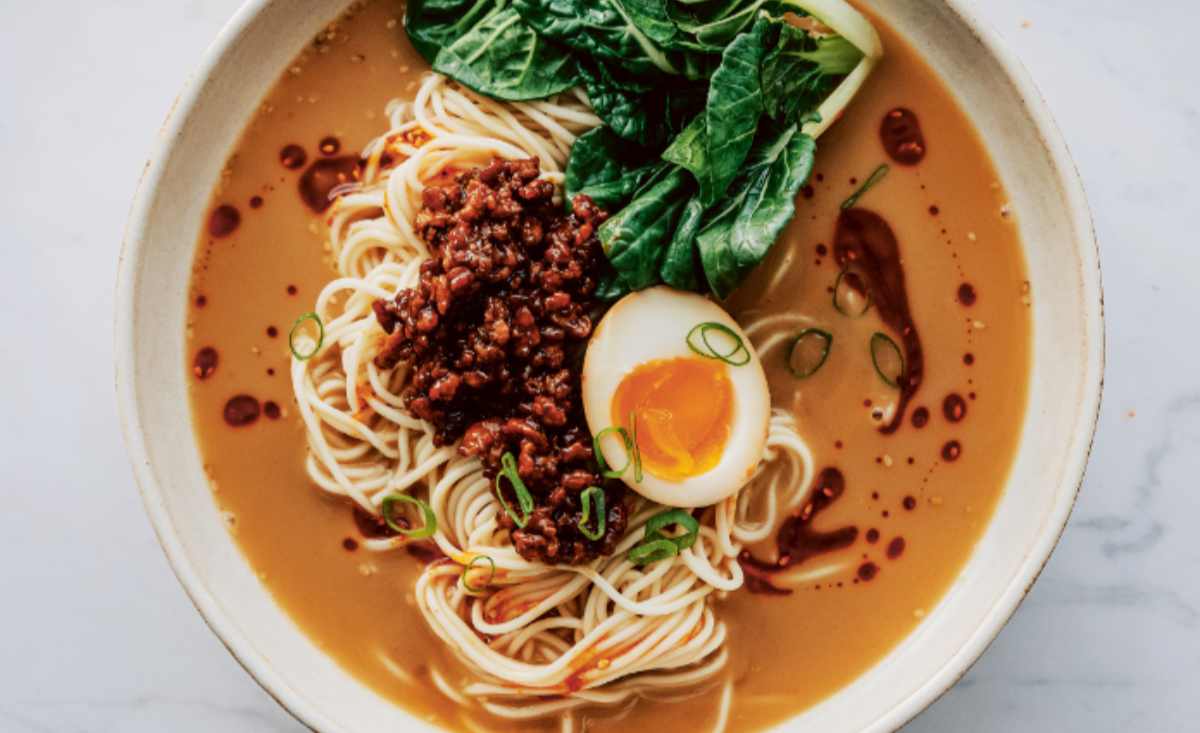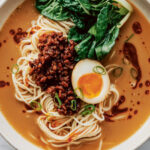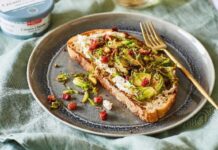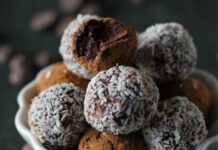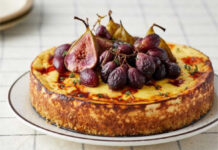Fans of Sichuan dan dan noodles will love tantanmen – it’s essentially a Japanese version of the beloved Chinese dish.
With a broth packed with flavour, this recipe is best served with homemade ramen noodles – and you can easily sub out the minced beef for soy and leave out the egg if you’re vegan.
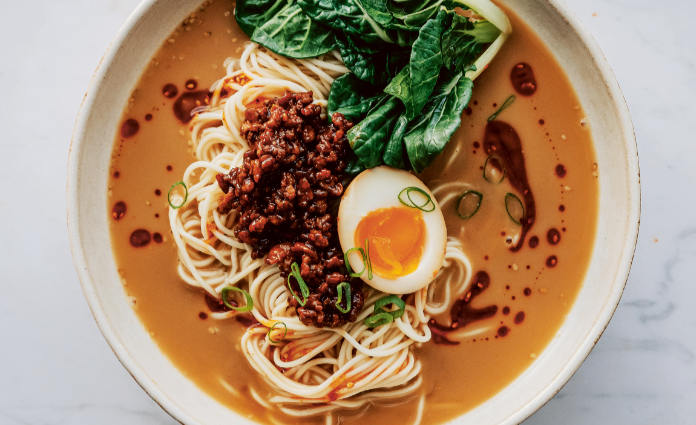
Tantanmen
Equipment
- sealable container
- pasta roller
- Large pan
- serving bowls
Ingredients
For the ramen noodles:
- 1/2 tsp sea salt
- 1/4 tsp kansui
- 130 grams high-protein flour
- Potato starch or cornflour (for dusting)
For the ramen eggs:
- 6 medium eggs
- 4 tbsp soy sauce light
- 4 tbsp mirin
- 250 ml dashi stock (made from powder) or water (cold)
For the meat sauce:
- 1 tbsp neutral oil
- 200 grams minced meat or 100g each of minced beef and pork
- 1 tsp Chinese five spices
- 2 tbsp Shaoxing rice wine
- 2 tbsp sweet bean sauce or hoisin sauce
- 1/2 tsp soy sauce dark
- 1/2 tsp black pepper freshly ground
To season the bowls:
- 1/4 tsp Sichuan peppercorn ground and sieved
- 1 tsp sesame seeds toasted
- 1/2 tsp brown sugar light
- 2 tsp Chinkiang black rice vinegar
- 4 tsp soy sauce light
- 2 tbsp Chinese sesame paste
- 2 tbsp Sichuan chilli oil or to taste
To serve:
- 2 pak choi leaves separated
- 200 grams ramen noodles fresh, or 100 grams dried ramen noodles
- 1 ramen egg
- 600 ml chicken or veg broth
- 1 spring onion finely sliced
Method
- For the ramen eggs: bring a pan of water to a rapid boil. Lower the eggs gently into the water and cook for exactly six minutes. Remove from the water and run under very cold water for three to four minutes, or plunge into a bowl of water and ice cubes. When completely cool, peel the eggs.
- Combine the soy, mirin and dashi. Submerge the eggs in the liquid and cover with baking paper. Alternatively, place the eggs in a sealable container or resealable plastic bag filled with the liquid. Leave in the fridge overnight to chill and marinate before eating. Will keep in the fridge for up to five days.
- For the ramen noodles (if making): combine the salt, kansui and water, pour over the flour and mix until dry straggles have formed. Bring the dough together into a ball. To do this, apply pressure using the palm of your hand in a downward motion. Continue to do this until the straggles of dough are forced together to form a rough ball and cover with a damp dish towel, and rest for 15 minutes.
- In the meantime, set up your pasta roller. Clamp it firmly to your worktop as the dough is extremely hard. Remove the dough from the bowl. Take a rolling pin and press firmly onto the dough, section by section, until the it is thin enough to pass through the pasta roller on its widest setting. Pass the dough through. What will emerge may be quite rough and ragged – this is OK! If the sheet has separated, or holes have appeared, don’t worry. Pass the dough through again on the widest setting and repeat this step until you have one complete sheet of dough, with no holes. Reset the pasta roller setting to the next narrowest setting. Pass the sheet of dough through. Reduce the setting once more, to the third narrowest setting. Pass the dough through.
- Now fold the dough in half, lengthways, and pass through the pasta roller on the widest setting. Repeat this sheeting and folding process until you have a smooth and even-textured sheet of dough. The edges of the sheet may have become dry and cracked – this is a result of the folding – but this is OK. Gently fold the sheet of dough in half and leave to rest for 30 minutes, covered with a clean dish towel.
- Once rested, unfold the dough sheet and pass through the pasta roller again to create a thin sheet – on my pasta roller this is a number five. Pass the dough through the cutting attachment, then lightly dust the noodles with potato starch or cornflour (cornstarch) to keep the strands separate.
- Place in a sealed container or freezer bag. They get better with age and resting them for 24 hours will improve the texture. They are good for up to five days in the fridge, but can also be enjoyed straight away. Cook the noodles in boiling salted water for 90 seconds. Rinse under cold water and serve in your chosen recipe.
- For the tantanmen: put a large pan of salted water on to boil. Blanch the pak choi for 30 seconds, scoop out, then set aside. Cook the noodles in the same water until al dente according to the packet. Drain, then rinse in plenty of cold water to stop them from sticking together. Set aside.
- To make the sauce, heat the neutral oil in a heavy-based frying pan or wok over a high heat. Add the minced meat and let it caramelise for at least one minute, without stirring. Stir, then continue to cook for five to six minutes until browned all over. Add the Chinese five spice and cook for 30 seconds. Pour in the rice wine, stir again, then add the sweet bean sauce or hoisin, dark soy sauce and black pepper. Mix well, turn down the heat and cook for another two minutes.
- Add the ramen egg to a mug of boiling water to gently reheat. Heat the broth until steaming.
- To assemble, divide all the bowl seasonings between two serving bowls. Pour in the hot broth and mix well to combine. At the last moment, add the noodles, top with meat sauce, half a ramen egg each, sliced spring onions and the blanched pak choi.
Nutrition
Bowls & Broths by Pippa Middlehurst is published by Quadrille. Photography by India Hobson & Magnus Edmondson.
No products found.
You may be interested in…
This article may include affiliate links to products and services where we may receive a small fee to support the running of this site if you make a purchase or is a sponsored article from one of our select editorial partners providing valuable advice and information to our readers.























































